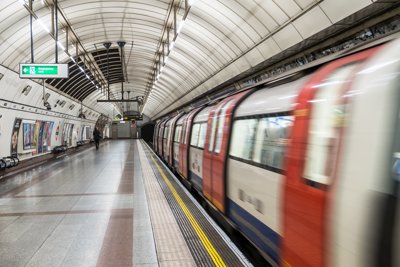Tristan Shearing works as a London Surveyor for Ordnance Survey (OS)
How did you become a surveyor?
I returned from a few years of working abroad, and thought “Which company would I most like to work for?” I have always loved maps, so Ordnance Survey was the first website I checked, and sure enough, there were vacancies for surveyors in London.
During the interview they test to see if you can read a map well and identify mistakes and changes, and whether you could work outside all day on your own.
What does your job entail?
I visit sites across the London boroughs of Hackney, Camden and the City of London keeping our large-scale maps in these areas up-to-date. Using a digital tape measure, GPS and sometimes a Total Station, I survey new buildings, roads, walls, paths – anything that meets our specification. I then add building numbers and names, address and road routing information before returning the data to our head office in Southampton to add it to the database. Along with my 16 colleagues in the London team, and 250 surveyors across the country, we ensure Britain’s maps are up-to-date. Ordnance Survey makes a remarkable 10,000 changes every day to the mapping database for Great Britain.
What geographical skills do you use?
I use GIS (Geographical Information Systems) software to plan my day’s work, so I know the job is ready to survey and I do not spend too long travelling. Once out on the ground, I need to be able to look at a map and quickly see what has changed in real life. I use modern technology such as GPS kits that can give me a position down to 1cm accuracy, but I also have the skills to survey a building using a tape measure, should the technology let me down. The current trend for building taller and taller skyscrapers in central London creates a challenge for me – my GPS needs a fairly open sky to see enough satellites to get the accurate fix I need. This means the most modern buildings can have me reaching for my simple tape measure to get them on the map.
What do you love about your job?
The best thing for me is working outside almost every day, and getting to know London really well. I get to survey some fascinating and important buildings, and no two days are the same. It is rewarding knowing I am directly making improvements to a map used by thousands of people, businesses and government departments across the country.
What changes have you recorded and made in London?
A wide range, from entire housing estate redevelopments to individual bus shelters and post boxes. I have surveyed the ‘Cheesegrater’ and ‘Walkie Talkie’ skyscrapers in the City, the new Kings Cross Station, Saracen’s Rugby Stadium, new schools and hospitals and countless new private homes.
What sorts of changes are typically happening in London?
We spend a lot of time surveying new houses and flats, whether it’s the rebuilding of big 1960s housing estates, or private home owners demolishing and rebuilding their houses. Many new schools have been built in London in the last few years, and we survey each one. Areas such as Battersea and Kings Cross are being completely redeveloped from industrial sites to homes and office buildings, so these areas keep us very busy. We surveyed the Olympic Park at Stratford before the 2012 Games showing all the venues – now we are back there surveying the site again as they remove some of the stadiums and build new flats. Transport links are also constantly changing, from the widening of the M25, the new terminal building at Heathrow and the new Crossrail stations, down to the Cycle Superhighways and Cycle Hire stations – all have to be surveyed so they appear on the map.
What is the most surprising thing you have ever had to map?
One of my first jobs involved donning a lifejacket and surveying a floating pontoon for a sailing club on a choppy, blustery, Royal Victoria Dock. My previous job was a sailing instructor so I felt at home on the water, but it was not what I expected working in Central London!
How is OS data used in different ways in London?
Ordnance Survey is best known for the 1:25000 and 1:50000 scale maps (Explorer and Landranger), and these are used by many people in London for planning routes for driving, cycling and walking, or finding their nearest park or station. I have seen them on the walls of estate agents covered in pins, and even printed on wallpaper in a house. You can now get these maps on your phone or tablet with our Mapfinder app. Our paper maps are an important part of our brand and heritage, however today they only account for seven percent of our annual revenue.
Ordnance Survey is a digital organisation with digital mapping being used across many aspects of our daily lives from helping to get people from A to B with in car sat nav systems and mobile apps to underpinning vital services such as utilities and the emergency services. We also have many customers using our detailed digital maps, down to a 1:1250 scale. For example, building developers and architects use our mapping when planning new developments, and councils use our routing data when planning the best routes for school buses, or refuse collections. The fire service can look at our maps when they receive an emergency call so they know the size of the burning building and how to access it, before they arrive. A customer can use our maps to see who will be affected by flooding, or find the address and location of every home, shop and business in the country.
